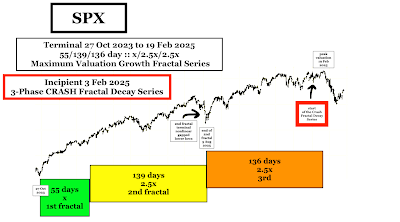Wednesday, March 26, 2025
THE INCIPIENT 3-PHASE LAMMERT 2025 CRASH FRACTAL DECAY SERIES
The diversity in the respective evolutions of quantitative fractal valuation growth and decay of the European(STOXX 600), United States, Chinese including HangSeng, Japanese and Indian composite equities, which account for more than 85% percent of total global market equity share, allows the pinpointing the US composite equities primary incipient daily decay crash fractal series.
Over the last several weeks, this web site has presented several different incipient primary fractal decay models similar to the 12/29/27 day :: y/2-2.5y/2-2.5y decay fractal series in 1929 with the 3 Sept (DJIA) 1929 peak valuation contained in the 29 day 2nd fractal.
The 1929 crash occurred near the terminal portion of an 1807 36/90 year :: x/2.5x 1st and 2nd fractal series with nadir valuations in 1842-43 and 1932. 2nd fractals are characterized (as noted in the 2005 opening page) by nonlinear gapped lower lows. There was a 90% devaluation in the terminal portion of the 90 year 2nd fractal from its 1929 peak to its 1932 nadir valuation.
The 2025 crash will occur in an interpolated 1982 13/32-33 year :: x/2.5x 1st and 2nd fractal series with lows in 1994 and a 2nd nonlinear low expected in 2025-2026 near the terminal portion of its 32-33 year 2nd fractal and after its 19 Feb 2025 high valuation.
This 1982 interpolated fractal sequence is occurring in a 1807 36/90/90/54 year fractal series which is expected to end in 2074.
Below is a primer review of the fractal time-based laws of the self ordering asset-debt macroeconomy’s growth and decay valuations of its composite assets.
Credit expands, assets are produced and over-produced and overvalued and over-consumed; composite asset valuations reach a singular peak valuation and thereafter undergo decay, recessions occur, excess debt undergoes default and restructuring, and composite asset valuations reach a nadir. The cycle repeats itself.
Empirically the cycles occur in 2 mathematical time- ordered and self-organizing fractal series manners:
a 4-phase fractal series: x/2-2.5x/2-2.5x/1.5-6x and
a 3-phase fractal series: x/2-2.5x/1.5-2.5x
In the 4-phase fractal series sequential elements are termed: the 1st, 2nd, 3rd, and 4th fractals and in the 3-phase fractal series: the 1st, 2nd, and 3rd fractals.
The 2nd fractal is characterized by terminal gapped lower lows between the 2x and 2.5x time period. (These gapped lower lows can be seen in weekly units between 1929 and 1932 of the US 90 year 2nd fractal, before the 5 August 2024 139 day 2nd fractal low and can be expected within last few months of the 32-33 year 2nd fractal of the interpolated 1982 13/32-33 year 1st and 2nd fractal series.)
With the exception of the 3rd fractal in the 4-phase series whose fractal grouping is determined by its terminal peak valuation, fractals (fractal groupings) are determined by the nadirs of the first and last time unit in the grouping with intervening valuation above the connecting nadir trend-line.
The recent incipient crash fractal series decay models provided over the last several week have all lacked the requirements defining fractal groupings as described above.
The final SPX growth series started on 27 October 2023 and was a 55/139/136 day :: x/2.5x/2.5x maximum growth series peaking on 19 February 2025 akin to 3 Sept 1929 peak valuation.
The incipient crash 3-phase fractal decay series for the SPX is a 3 February 8/19/12 of 20 day :: y/2-2.5y/2.5y fractal decay series.
Like 1929 the peak valuation on 19 February 2025 is contained in the (19 day) 2nd fractal. Trend lines defining fractal groupings are consistent with this model.
Subscribe to:
Post Comments (Atom)



No comments:
Post a Comment